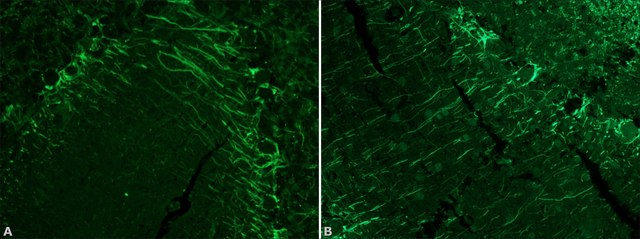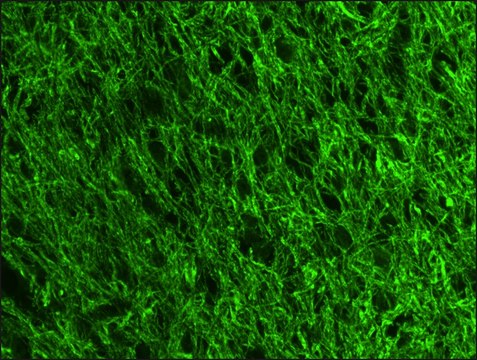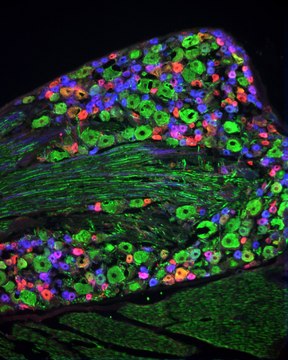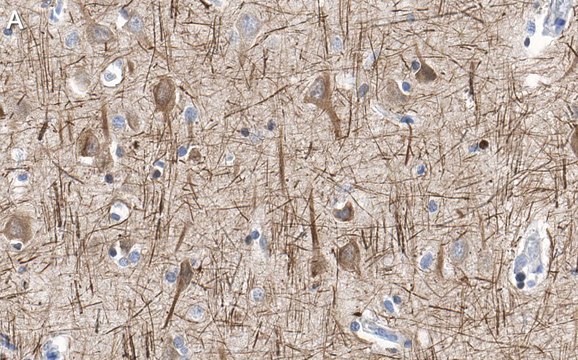추천 제품
제품명
Monoclonal Anti-Neurofilament 200 antibody produced in mouse, clone NE14, ascites fluid
생물학적 소스
mouse
Quality Level
결합
unconjugated
항체 형태
ascites fluid
항체 생산 유형
primary antibodies
클론
NE14, monoclonal
분자량
antigen apparent mol wt 200 kDa
포함
15 mM sodium azide as preservative
종 반응성
pig, mouse, chicken, bovine, guinea pig, rabbit, rat, human
향상된 검증
independent ( Antibodies)
Learn more about Antibody Enhanced Validation
기술
immunohistochemistry (formalin-fixed, paraffin-embedded sections): 1:40
immunohistochemistry (frozen sections): suitable
microarray: suitable
western blot: suitable
동형
IgG1
UniProt 수납 번호
배송 상태
dry ice
저장 온도
−20°C
타겟 번역 후 변형
unmodified
유전자 정보
human ... NEFH(4744)
일반 설명
Monoclonal Anti-Neurofilament 200 (mouse IgG1 isotype) is derived from the hybridoma produced by the fusion of mouse myeloma cells and splenocytes from an immunized mouse. The neurofilaments are one of the five major groups of intermediate filaments (IFs) and are found predominantly in cells or tissues of neuronal origin. They are composed of three major proteins of apparent molecular weights 68 kD, 160 kD, and 200 kD and are named as NEFL (light), NEFM (medium) and NEFH (heavy) respectively. Neurofilament proteins are synthesized in the neuronal perikarya, assembled to form filaments and then slowly transported within the axons towards the synaptic terminals.
면역원
pig spinal cord.
애플리케이션
Applications in which this antibody has been used successfully, and the associated peer-reviewed papers, are given below.
Immunofluorescence (1 paper)
Immunohistochemistry (1 paper)
Immunofluorescence (1 paper)
Immunohistochemistry (1 paper)
Monoclonal Anti-Neurofilament 200 antibody produced in mouse has been used in
- immunohistochemistry
- immunolabeling
- immunofluorescence
생화학적/생리학적 작용
Neurofilament heavy chain (NEFH) gene was recently identified to cause autosomal dominant axonal Charcot-Marie-Tooth disease (CMT2cc). This gene plays a role in the pathogenesis of sporadic amyotrophic lateral sclerosis (ALS). The phosphorylation of neurofilament polypeptides has been suggested to modulate their function by influencing the interaction between neurofilament and cytoplasmic organelles.
면책조항
Unless otherwise stated in our catalog or other company documentation accompanying the product(s), our products are intended for research use only and are not to be used for any other purpose, which includes but is not limited to, unauthorized commercial uses, in vitro diagnostic uses, ex vivo or in vivo therapeutic uses or any type of consumption or application to humans or animals.
적합한 제품을 찾을 수 없으신가요?
당사의 제품 선택기 도구.을(를) 시도해 보세요.
Storage Class Code
10 - Combustible liquids
WGK
WGK 3
Flash Point (°F)
Not applicable
Flash Point (°C)
Not applicable
이미 열람한 고객
Cell cycle kinetics and immunohistochemical characterization of dissociated fetal neocortical cultures: evidence that differentiated neurons have mitotic capacity
Jacobs JS and Miller MW
Dev. Brain Res., 122(1), 67-80 (2000)
Neurofilament proteins are synthesized in nerve endings from squid brain
Crispino M, et al.
Journal of Neurochemistry, 61(3), 1144-1146 (1993)
Pamela Imperadore et al.
Scientific reports, 7, 46564-46564 (2017-04-21)
Regeneration is a process that restores structure and function of tissues damaged by injury or disease. In mammals complete regeneration is often unsuccessful, while most of the low phyla animals can re-grow many parts of their body after amputation. Cephalopod
C Lois et al.
Proceedings of the National Academy of Sciences of the United States of America, 90(5), 2074-2077 (1993-03-01)
Subventricular zone (SVZ) cells proliferate spontaneously in vivo in the telencephalon of adult mammals. Several studies suggest that SVZ cells do not differentiate after mitosis into neurons or glia but die. In the present work, we show that SVZ cells
Structural correlates of active-staining following magnetic resonance microscopy in the mouse brain.
Jon O Cleary et al.
NeuroImage, 56(3), 974-983 (2011-02-12)
Extensive worldwide efforts are underway to produce knockout mice for each of the ~25,000 mouse genes, which may give new insights into the underlying pathophysiology of neurological disease. Microscopic magnetic resonance imaging (μMRI) is a key method for non-invasive morphological
자사의 과학자팀은 생명 과학, 재료 과학, 화학 합성, 크로마토그래피, 분석 및 기타 많은 영역을 포함한 모든 과학 분야에 경험이 있습니다..
고객지원팀으로 연락바랍니다.













